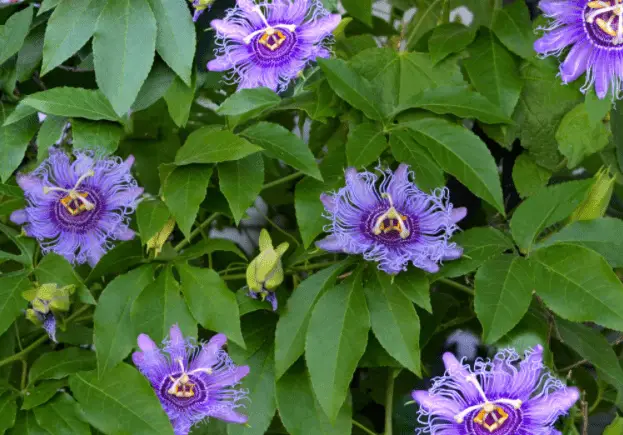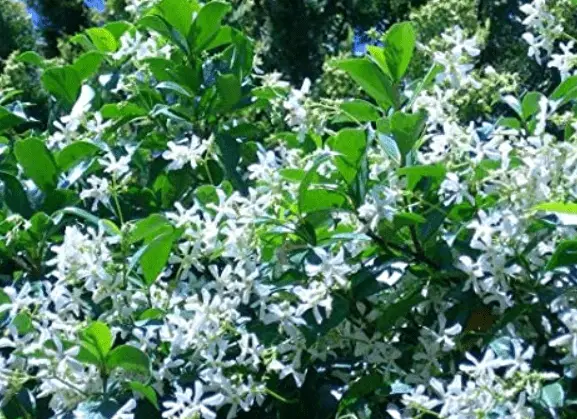Adding vines on pergolas is a great way of providing shelter, privacy and shade on patios, porches or garden. The vertical greenery also add spectacular ambience that enhance aesthetic value of these outdoor spaces. While there are many different types of climbing plants, let us delve on best fast growing vines for pergolas, arbors and trellis.
1. Climbing Rose

Roses come in varieties of colors including white, peach, yellow, pink, red, lavender, orange and ivory among others. These sweet smelling flowers can grow 40 feet or more depending on the species. Roses are favorite among most gardeners as they portray a special sense of love, happiness, nostalgia and tranquility.
Climbing varieties of roses are aggressive and thus the best for covering pergolas and arbors. They can be planted in containers or bare-root. Spring is the best time to grow your roses, watering and fertilizing regularly will make them to grow faster. Roses require pruning as a way of making them grow dense look decent.
2. Bougainvillea

Bougainvillea has vibrant colorful bracts that come in various shades of red, pink, white, orange, white and yellow. The shrub can be grown as groundcover on slopes, next to buildings as wall covering, as a flower in containers and mostly as a climbing plant on pergolas and arbors.
Most varieties of bougainvillea grow 20 to 30 feet tall. Bougainvillea thrives in full sun and the best time to plant is in spring or early summer to allow its roots to get established before cooler weather sets in. The slight acidic soil should be well-drained and on higher ground, as the plant does poorly in water-logged or low areas.
3. Clematis

Clematis are beautiful perennial vines with a rich tapestry of color and texture. They can reach a height of 20 feet although they come in a wide range of heights. Their twining stems or clinging stem roots makes them to easily climb over arbors and twist themselves through other plants.
Clematis flowers in late spring, summer or in the fall although the blooming times, flower forms and colors vary. Flower styles include star-like singles, frilly doubles, delicate miniatures and bell-shaped blossoms. Depending on the species, the colors may include white, red, pink, burgundy, lavender, deep purple and even yellow.
These long-lived vines require well drained soil that’s rich and loamy for optimum growth. To make them spread faster, ensure the root is ever in cool zones. Shade from other plants or mulching may help. Clematis require support to grow well, you may also plant it against a wall, with other shrubs or vines or on a free-standing trellis.
4. Honeysuckle

Everyone knows honeysuckle for its nectar-filled tubular and sweet scented flowers. Climbing honeysuckle is hardy and heat tolerant plant suitable for pergolas, arbors, trellis and walls. This plant is highly attractive to bees, butterflies, and hummingbirds due to presence of nectar.
With dark green to blue-green leaves, honeysuckle can be grown as either far-reaching vines or arching shrubs. The sweet-smelling flowers can bloom in bright pinks, oranges, yellows or whites with some species having flowers with two colors.
Early spring is the ideal time to grow a climbing honeysuckle after any threat of frost has gone. It should be in a sunny location with well-drained moist soil. Proper watering and training the vine to grow up a pergola, wall or trellis using a plastic tie tape will make it to establish faster. Pruning is not much essential with a climbing honeysuckle.
5. Grapes

Grape vines not only add shade to a garden or landscape but also produce nutritious sweet fruits. They are vigorous plants ideal for covering pergolas and arbors. However, location is everything for you to get that natural backyard privacy screen that also give you a privilege to make a wine.
Grapes need full sun ranging from 6 to 8 hours a day. Although they grow in a wide range of soils, proper drainage is mandatory. Tie up the young plants until they are tall enough to hang on their own. Once established, grapes are fast growing vines that may overwhelm a weak structure. Ensure the pergola or trellis are strong enough to support the weight.
6. Passion Flower

This is a fast growing hardy perennial you can have in your garden to offer shade or privacy. A grown passion flower will grow more than 40 feet and attach to the structure or other plants with coiled tendrils.
Passion flower come in varieties of species some with colorful flowers including white, red, pink, purple, yellow, and orange, with different colors at their centers. The flowers are extremely attractive to pollinators including butterflies and after some time some species will bear edible fruits which should only be eaten when ripe.
Passion flowers should be grown in full sun in a well-drained soil. Because they are vines, train them until they grow to a level where they can grab on their own. Although top section of the plant will be killed off during winter, deep mulching would help the plant to shoot back in the spring.
7. Jasmine

Jasmine is known for its unique tropical smell and pretty blossoms that attract bees and other pollinators. The flowers are white and yellow or cream for some species. Jasmine can be grown and be trained to climb on trellis or your pergola to provide shade and privacy.
Jasmine has bright green, glossy foliage and thrives in full sun to light shade. The evergreen plant requires relatively fertile and well-drained soil. Any time between June and November will be ideal for planting jasmine. Watering and support of the tender plant will make it to establish and spread faster.
8. Bower Vine

This is a fast growing vine that can add color to the landscape all summer with its soft pink, bell-shaped blooms. Further, the lush, evergreen foliage can provide great shade and privacy on patios, porches, walkways and garden.
Bower vine thrives in full sun to partial shade areas. After growing the vine, water adequately to encourage deep roots. Allow the soil to dry between each watering and thereafter spread a thin layer of mulch around the plant to help in conserving moisture. Providing supportive structures and training the vines to climb makes bower plant to establish quickly.
Prune after blooming has ended to keep the climbing in control but don’t cut it down. Applying rich fertilizer in late spring and early fall or for the first two years will make it strong and lush. Once the plant is established, little care will be required.
9. Trumpet Vine

Also known as trumpet creeper, this is a fast growing perennial vine for covering pergolas, arbors walls and other structures. This aggressive climbing plant features trumpet-shaped yellow, orange, or red flowers that attracts hummingbirds.
Trumpet Vine is tolerant to hot and dry conditions and will require sturdy structural support. If uncontrolled, this vine can overwhelm trees, weak structures and even buildings. It requires plenty of space thus plant it away from trees and foundations.
Full sun to partial shade is just fine for a trumpet vine. It does well in almost every soil and watering is only necessary when the plant is showing signs of withering. There is no need for fertilizer as well. This is the only easier way of controlling the aggressive plant. Pruning a trumpet vine is almost impossible. As part of taming the plant, cut it down to ground level early in the spring.
10. Wisteria

Wisteria is a long-lived vine that blooms in spring and early summer with large, drooping clusters of lilac or bluish-purple flowers. This fast growing vine looks spectacular on pergolas, archway, arbors and trellises. However, this vine is aggressive and know to grow heavy if not controlled.
CAUTION: Wisteria plant contains toxic substances to pets, livestock and even humans when consumed.
Wisteria thrives in full sun to partial shade. The soil should be fertile, moist and well-drained. The aggressive plant should be grown away from your home and other plants. The support structure should be strong enough to support the heavy vine lest it will break.
It is also good to note that, wisteria will take long to bloom. Pruning seems to help in stimulating this plant to bloom and also as a way of controlling it. Do the pruning in late winter and in summer after the flowering.
Conclusion
Growing vines on pergolas and arbors is one of the cheapest patio cover ideas you can implement in your home. Additionally pergola plants come with other benefits that include filtered shade, fresh scent of flowers, and easy maintenance.

